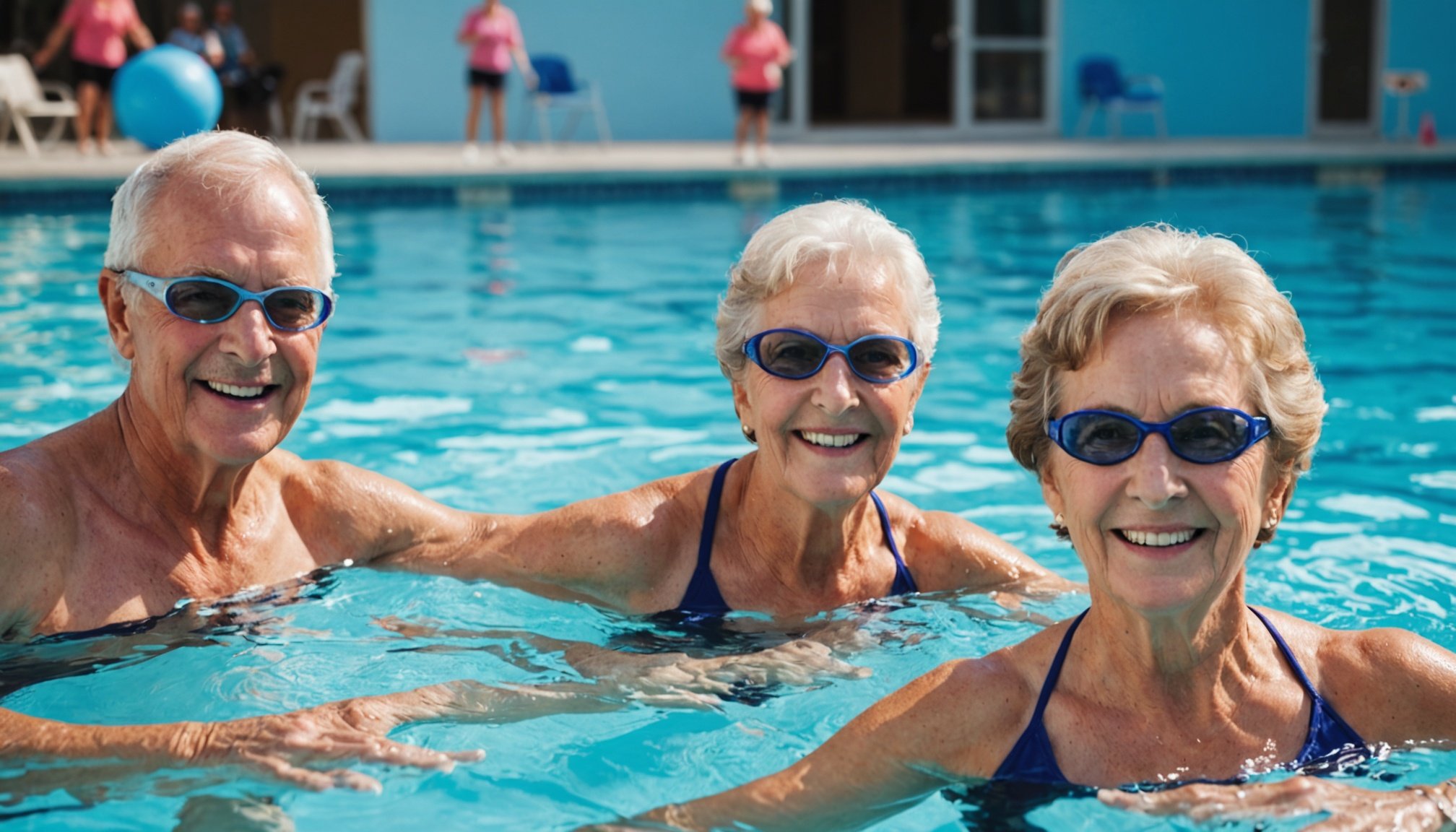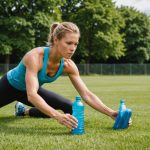Unlocking Joint Health: The Remarkable Benefits of Aquatic Aerobics for Seniors
As we age, maintaining joint health and overall fitness becomes increasingly important. For seniors, traditional land-based exercises can often be daunting due to joint pain, limited mobility, or balance issues. However, there is a solution that offers a fun, effective, and low-impact way to stay active: aquatic aerobics.
The Unique Benefits of Aquatic Aerobics
Aquatic aerobics, also known as water aerobics or aqua fit, is a fitness activity performed in water that combines cardiovascular exercise, strength training, and flexibility movements. Here are some of the unique benefits that make it an ideal choice for seniors.
Also to discover : Discover How a Plant-Based Diet Can Alleviate Symptoms of Ulcerative Colitis: Unveiling the Benefits
Low Impact and Joint Friendly
One of the most significant advantages of aquatic aerobics is its low-impact nature. The water’s buoyancy reduces the stress on joints, making it an excellent option for seniors dealing with arthritis, joint pain, or limited mobility. As Connie Smith, the healthy living director for Florida’s First Coast YMCA, notes, “The water’s resistance and the cushion water provides for reduced impact on your joints allow you to gain strength while minimizing aches and pains”[3].
Enhanced Muscle Strength and Endurance
Aquatic aerobics utilizes the natural resistance of water to build muscle strength and endurance. Unlike traditional strength training that requires heavy weights, water resistance provides a gentle yet effective workout. For example, exercises like arm curls with water dumbbells and pool squats engage multiple muscle groups without overexertion, making them perfect for maintaining muscle tone as we age[1].
Also to discover : Unlocking Relief: The Impact of a High-Fiber Diet on Diverticulitis Symptoms Management
Key Exercises in Aquatic Aerobics
Here are some key exercises that are commonly included in aquatic aerobics classes, tailored specifically for seniors:
Water Walking
Water walking is one of the most accessible and effective low-impact workouts for seniors. It involves walking through the water, which improves overall cardiovascular health, enhances muscle strength, and supports joint health. This exercise engages multiple muscle groups, including the legs, core, and arms, without putting unnecessary stress on the body[1].
Arm Curls with Water Dumbbells
For seniors looking to maintain or build upper body strength, arm curls with water dumbbells are an excellent choice. Standing in chest-deep water, seniors can perform traditional arm curls using water dumbbells, which strengthens the biceps and engages other muscles in the arms and shoulders[1].
Shoulder Rolls
Shoulder rolls are an effective way to increase shoulder mobility and reduce stiffness. This exercise involves gently rotating the shoulders in circular motions, both forward and backward, in chest-deep water. It improves posture, reduces pain, and helps seniors maintain their upper body mobility[1].
Pool Squats
Pool squats are a modified version of traditional squats, performed in chest-deep water. This exercise strengthens the legs and core while reducing the strain on the knees and hips, thanks to the water’s buoyancy. It is crucial for maintaining balance and stability, which are essential for preventing falls[1].
Health Benefits of Aquatic Aerobics
Aquatic aerobics offers a myriad of health benefits that are particularly beneficial for seniors.
Cardiovascular Health
Aquatic aerobics is an excellent way to improve heart health by increasing circulation, lowering blood pressure, and enhancing cardiovascular endurance. The rhythmic movements and water resistance help in improving heart rate and overall cardiovascular fitness[5].
Weight Management
Regularly attending aqua aerobics classes can aid in weight management by burning calories and boosting metabolism. This is especially beneficial for seniors who may find it challenging to engage in high-impact exercises for weight loss[5].
Improved Mobility and Flexibility
Aquatic aerobics helps improve joint mobility and promote flexibility. The water’s properties allow for a range of motion that is often difficult to achieve on land, reducing the chances of injury from high-impact exercises. This is particularly beneficial for seniors who experience joint pain or limited range of motion[5].
Mental Health and Social Benefits
Aquatic aerobics classes offer a supportive and social environment where participants can laugh, make friends, and stay motivated to maintain a regular exercise routine. The soothing properties of water combined with rhythmic movements can reduce stress and promote relaxation, which is crucial for mental health and overall well-being[5].
Practical Insights and Actionable Advice
If you are a senior considering aquatic aerobics, here are some practical insights and actionable advice to get you started:
Finding the Right Program
Look for local community centers, retirement communities, or swimming schools that offer aquatic aerobics classes specifically designed for seniors. Many places, like the Conservatory at Keller Town Center, offer heated pools and regular water exercise sessions[1].
Starting Slow
Begin with gentle exercises like water walking or shoulder rolls. As you become more comfortable, you can gradually incorporate more intense exercises like arm curls with water dumbbells or pool squats.
Using Proper Equipment
Invest in water dumbbells or other aquatic exercise equipment that can help you get the most out of your workout. These tools provide additional resistance and support, making the exercises more effective.
Joining a Class
Joining an aquatic aerobics class can be highly motivating and fun. It provides a social environment where you can meet new people and stay engaged in your fitness journey.
Comparative Benefits of Aquatic Aerobics
Here is a comparative table highlighting the benefits of aquatic aerobics versus traditional land-based exercises:
| Benefit | Aquatic Aerobics | Traditional Land-Based Exercises |
|---|---|---|
| Impact on Joints | Low impact, reduces stress on joints | High impact, can exacerbate joint pain and mobility issues |
| Muscle Strength | Builds muscle strength and endurance using water resistance | Requires heavy weights or equipment, can be overexerting |
| Cardiovascular Health | Improves heart health by increasing circulation and lowering blood pressure | Can be high-impact, may not be suitable for all seniors |
| Weight Management | Aids in weight loss by burning calories and boosting metabolism | Often requires high-impact activities that may be challenging for seniors |
| Mobility and Flexibility | Improves joint mobility and promotes flexibility | May not be as effective for improving range of motion and flexibility |
| Mental Health | Reduces stress and anxiety, promotes relaxation | May not offer the same level of relaxation and social interaction |
| Social Benefits | Provides a supportive and social environment | Often individual activities or group classes that may not be as engaging |
Real-Life Examples and Testimonials
Many seniors have found aquatic aerobics to be a game-changer in their fitness journey. Here are a few testimonials that highlight the positive impact of these exercises:
- “Aquatic aerobics has been a lifesaver for me. I was struggling with arthritis and couldn’t do much on land, but the water exercises have given me back my mobility and strength,” says Jane, a 75-year-old participant at Saguaro Aquatics[5].
- “I love the social aspect of aquatic aerobics. It’s not just about exercising; it’s about making friends and having fun while staying fit,” adds Tom, a 68-year-old resident at the Conservatory at Keller Town Center[1].
Aquatic aerobics is more than just an exercise routine; it’s a holistic approach to health and fitness that caters specifically to the needs of seniors. With its low-impact nature, it offers a safe and effective way to maintain joint health, build muscle strength, and improve overall well-being. Whether you’re looking to manage weight, improve cardiovascular health, or simply enjoy a fun and social way to stay active, aquatic aerobics is an excellent choice.
So, why not dive into the world of aquatic aerobics? Your body—and your joints—will thank you. As Connie Smith aptly puts it, “Aqua aerobics is just fabulous for this age group. It’s a way to stay active, have fun, and maintain your health without the aches and pains”[3].
Real-life Testimonials and Research Findings
Research studies underscore the significant impact aquatic aerobics can have on senior health. Widely praised for its buoyant, low-impact nature, this form of exercise is particularly effective in enhancing mobility and strength. In a study published by the National Institute on Aging, participants aged 65 and older saw marked improvements in both balance and joint flexibility. This research highlights why aquatic aerobics is an excellent choice for seniors seeking to stay active without putting undue stress on their bodies.
Testimonials of Transformation
Indeed, real-life testimonials offer a window into the tangible benefits of these exercises. For instance, Mary, a 72-year-old participant, shared that aquatic aerobics helped her regain confidence in her physical abilities after knee surgery. Similarly, George, who suffers from arthritis, reports experiencing reduced joint pain and increased energy levels, enabling him to partake in everyday activities with greater ease.
Observable Health Benefits
These personal experiences are backed by the positive health outcomes observed in participants. Regular engagement in aquatic exercises has led to reductions in blood pressure and improvements in cardiovascular fitness. These findings reinforce the inherent value of aquatic aerobics, not just as an exercise regimen, but as a gateway to a healthier, more fulfilling life for seniors.
Encouraging Participation in Aquatic Aerobics
Engaging in community programs such as aquatic aerobics can significantly enhance well-being. Many local community pools offer fitness classes tailored for various age groups, ensuring accessibility and enjoyment for everyone. These group sessions are not only a fantastic way to improve physical health but also foster social connections among participants.
Participating in group aquatic aerobics provides numerous benefits, including enhanced cardiovascular endurance, increased flexibility, and improved muscle strength. The buoyancy of water reduces the strain on joints, making these exercises an excellent choice for individuals with arthritis or mobility issues.
To boost motivation among seniors, several strategies can be employed. First, creating a welcoming environment can alleviate any intimidation they might feel. Encouraging testimonials from peers who enjoy and benefit from the classes can inspire participation. Offering free trial sessions or discounted rates for new joiners can also be an effective approach.
Ultimately, incorporating enjoyable music and varying routines ensures the experience remains lively and engaging, further enhancing participants’ commitment. By focusing on these aspects, community programs can successfully encourage more individuals to embrace aquatic aerobics, promoting a healthier and more active lifestyle for all ages.
Overview of Joint Health for Seniors
Maintaining joint health is crucial for seniors as they age, as it significantly impacts their mobility and quality of life. Aging naturally leads to wear and tear of the joints, which may result in common issues like arthritis, stiffness, and decreased flexibility. These conditions often limit the ability to perform daily activities, emphasizing the need to focus on joint care.
Physical activity plays a vital role in promoting joint health among older adults by strengthening muscles that support joints, maintaining bone density, and improving flexibility. Beneficial exercises include low-impact activities such as walking, swimming, and cycling, which reduce stress on the joints while providing cardiovascular and muscle-strengthening benefits.
Understanding and addressing these challenges can help seniors maintain a healthier, more active lifestyle. Seeking professional advice from healthcare providers or physical therapists can further assist in creating personalised exercise regimes tailored to individual needs and limitations, fostering optimal joint health.
Seniors should remain vigilant about their joint health, as addressing issues early can prevent more severe conditions. Incorporating balanced nutrition, proper hydration, and regular check-ups can complement physical activity to enhance overall well-being as they age gracefully.
Benefits of Aquatic Aerobics for Joint Health
Aquatic aerobics is a low-impact exercise known to provide numerous joint benefits. The buoyancy of water supports body weight, reducing stress on joints while still allowing for effective workouts. This makes aquatic aerobics particularly suitable for individuals with joint issues such as arthritis, as the low-impact nature protects joints from excessive strain.
Engaging in aquatic aerobics can significantly improve flexibility and range of motion. Water resistance acts as a natural form of resistance training, gently encouraging movement that stretches and strengthens the muscles around the joints. This gradual enhancement supports joint stability, helping to prevent stiffness and maintain functional movement.
Additionally, the cardiovascular benefits of aquatic aerobics are substantial. Regular participation improves circulation, which is crucial in maintaining healthy joints. Enhanced blood flow delivers essential nutrients and oxygen to joint tissues, promoting repair and maintenance. As a result, individuals may experience reduced joint pain and an increased ability to perform daily activities comfortably.
Incorporating aquatic aerobics into a fitness routine presents a practical solution for promoting joint health. The combination of low-impact exercise, water resistance, and cardiovascular improvement delivers comprehensive benefits, making it an excellent choice for those seeking to protect and enhance joint function.
Recommended Aquatic Aerobics Activities for Seniors
Aquatic exercises are an excellent choice for seniors looking to enhance their fitness routines. The buoyancy of water provides a gentle resistance that is ideal for seniors’ workouts, reducing the risk of injury.
Specific Aquatic Aerobics Routines Ideal for Seniors
Water walking is a foundational exercise, allowing seniors to maintain cardiovascular health without placing stress on joints. For a more dynamic routine, try water jogging, which offers a full-body workout at a manageable intensity.
Arm lifts, with water resistance, aid in building upper body strength, while leg lifts enhance lower body flexibility. For a core-focused workout, seniors can engage in aqua Pilates, which combines the principles of traditional Pilates with the supportive environment of water.
Duration and Frequency Recommendations
To achieve optimal results, seniors are encouraged to participate in aquatic exercises three to five times a week. Each session should last approximately 30 to 60 minutes, allowing for a comprehensive workout that includes warm-up, main exercises, and cooldown.
Modified Exercises for Varying Levels of Ability
For those with limited mobility or comfort, modified exercises can be introduced. Using floating devices or shallow water can provide additional support. Consulting with a professional can ensure exercises are adjusted appropriately to suit individual needs.
Research and Testimonials Supporting Aquatic Aerobics
Aquatic aerobics offers a safe and effective exercise option for seniors, backed by compelling research studies and personal testimonials. Numerous studies highlight the evidence-based benefits of this activity, noting its positive impact on joint health and overall well-being.
For instance, research studies have demonstrated that aquatic aerobics can reduce joint pain and stiffness, which is vital for seniors struggling with arthritis. These studies underscore the lower impact forces experienced in water, allowing for smoother and more comfortable movements compared to land-based exercises. This setting is not only welcoming for seniors but also highly effective in maintaining joint flexibility.
Testimonials from seniors further support these findings. Many have reported significant improvements in their joint health after consistently participating in aquatic aerobics classes. One senior shared how aquatic sessions allowed them to move pain-free for the first time in years, inspiring others to consider this gentle yet effective exercise option.
In terms of safety and efficacy, the analysis of data from various trials consistently emphasizes the low-risk nature of aquatic aerobics for seniors. This ensures that senior participants can engage in a beneficial fitness routine while minimizing the chances of injury.
Safety Tips for Seniors Engaging in Aquatic Aerobics
Aquatic aerobics offer numerous health benefits for seniors, but following essential safety guidelines ensures a safe and enjoyable experience. Prioritizing seniors’ health, it’s crucial that participants wear appropriate non-slip footwear to prevent accidental falls when entering or exiting the pool.
Supervision is key. Engaging a trained professional to oversee classes not only enhances safety but also instills confidence among participants. These experts can offer exercise precautions tailored to individual needs, ensuring that routines are both effective and manageable. Additionally, they provide immediate assistance in case of any uncommon symptoms or emergencies.
Addressing common fears is vital. Many seniors may harbor concerns about water or overexertion. Ease these worries by starting sessions in shallow areas and gradually progressing to deeper waters. Effective communication between trainers and participants can demystify any barriers, ensuring a friendlier and more approachable atmosphere.
To further build confidence, establishing buddy systems can play a pivotal role. Having a classmate nearby offers emotional support and additional security. Lastly, maintaining hydration and ensuring a proper warm-up before sessions can safeguard against cramps and exhaustion. Engaging in aquatic aerobics with these exercise precautions in mind fosters not only fitness but also peace of mind.
Getting Started with Aquatic Aerobics
Starting out with aquatic aerobics can be an invigorating experience, especially for seniors looking to enhance their fitness in a gentle yet effective manner. Beginner tips are essential for those new to this exercise, ensuring a smooth transition into routine.
Locating Suitable Aquatic Facilities
Choosing the right aquatic facilities is crucial. Many community centres and gyms offer aquatic aerobics classes tailored to different fitness levels. It’s advisable to visit a few facilities to find one that meets your needs in terms of class size, schedule, and instructor expertise. Some venues may even offer trial classes to help you decide.
First Steps for New Participants
For seniors embarking on this watery journey, starting exercise with a set of achievable goals is beneficial. Most classes will have instructors who provide guidance to help adjust movements according to your ability. Ensure you’re comfortable and don’t rush—gradual progress is key.
Necessary Gear and Preparation
Appropriate preparation includes investing in quality swimwear and potentially other gear like aquatic shoes for better traction. Always bring a towel and water bottle to stay hydrated. Check with the facility about any additional gear or attire requirements before attending your class. Proper preparation enhances both safety and enjoyment of the class.









